|
|
 |
Fiche d'espèce de Copépode |
|
|
Calanoida ( Ordre ) |
|
|
|
Eucalanoidea ( Superfamille ) |
|
|
|
Eucalanidae ( Famille ) |
|
|
|
Eucalanus ( Genre ) |
|
|
| |
Eucalanus hyalinus (Claus, 1866) (F,M) | |
| | | | | | | Syn.: | ? Calanus erythrochilus Leuckart, 1859 (p.260);
Calanella hyalina Claus, 1866 (p.8);
Eucalanus elongatus var. hyalinus : Giesbrecht, 1892 (p.131, 133, figs.F,M); Bainbridge, 1972 (p.61, Appendix Table II, vertical distribution %); ? Valdés & al., 2007 (p.103: tab.1);
no Eucalanus spinifer T. Scott,1894 b (p.29);
? E. atlanticus Wolfenden, 1904 (p.113, figs. juv.M); Unterüberbacher, 1964 (p.16, Rem.);
Eucalanus elongatus : Farran, 1929 (part., 207, 218); Rose, 1933 ( p.67, figs.F,M); ? Jespersen, 1939 (p.38); ? Østvedt, 1955 (p.14: Table 3, p.56); Giron-Reguer, 1963 (p.25); ? Shmeleva, 1965 b (p.1350, lengths-volume -weight relation); Ramirez, 1969 (p.45, figs.F, Rem.); Corral Estrada, 1970 (p.72, figs.F,M); ? Bainbridge, 1972 (p.61, Appendix Table I: vertical distribution vs day/night); ? Razouls, 1972 (p.94, Annexe: fig.F); ? Boucher & Thiriot, 1972 (p.47, Tableau 4); ? P. Nival & S. Nival, 1973 (p.135, mouth parts, grazing); ? Harding, 1974 (p.141, Table 2, gut contents); ? Sameoto, 1984 (p.767, Table I, vertical migration); ? Cowles & al., 1987 (p.653, fig.6, 7, Table 4, vertical distribution, ingestion); ? Schnack, 1989 (p.137, tab.1, fig.6: Md); ? Seguin & al., 1993 (p.23, Table 2: abundance, %); ? Seguin & al., 1994 (p.376: Rem.); Sautour & al., 2000 (p.531, Table II, abundance); Daly Yahia & al., 2004 (p.366, fig.4); ? Mazzocchi & Di Capua, 2010 (p.425); ? Moscatello & al., 2011 (p.80, Table 4); ? Brugnano & al., 2012 (p.207, Table 2, 3); ? Aubry & al., 2012 (p.125, fig.8 a, b, interannual variation); ? Bode & al., 2012 (p.108, spatial distribution vs time-series, % biomass); ? Belmonte & al., 2013 (p.222, Table 2, abundance vs stations); ? Lidvanov & al., 2013 (p.290, Table 2, % composition); ? Marques-Rojas & Zoppi de Roa, 2017 (p.495, Table 1); ? El Arraj & al., 2017 (p.272, table 2, seasonal composition);
No E. elongatus hyalinus : Brodsky, 1950 (1967) (p.103, figs.F); Vervoort, 1963 b (p.88, Rem.); Paiva, 1963 (p.18, Rem.); Grice & Hulsemann, 1967 (p.13); Fleminger, 1967 a (tabl.1); Marques, 1968 a (p.395); Park, 1970 (p.474); Corral Estrada, 1970 (p.72, figs.F, juv.M, Rem.: p.73); Gueredrat, 1971 (p.300); ? Heinrich, 1973 (p.95); ? Björnberg, 1973 (p.299, 386, Rem.); ? Kovalev & Shmeleva, 1982 (p.82); Vives, 1982 (p.290); Onishchik, 1999 (p.76, figs.2, 3, 4, 5);
? E. elongatus var. hyalinus : Giesbrecht, 1892 (p.131, 150, figs.F,M); Pearson, 1906 (p.6); Farran, 1908 b (p.22); Wolfenden, 1911 (p.204); Pesta, 1920 (p.498); Sars, 1925 (p.20); Rose, 1925 (p.151); Farran, 1926 (part., p.230); Bigelow, 1926 (p.228); Rose, 1933 a (p.67, figs.F,M); Jespersen, 1934 (p.46); 1940 (p.11, fig.3); M.W. Johnson, 1938 (p.165, figs.F, Rem.); Massuti Alzamora, 1942 (p.86); Marques, 1947 (p.35); 1953 (p.94); 1956 (p.223); 1959 (p.206); 1961 (p.51); Vervoort, 1957 (p.32); Owre, 1962 (p.491); Duran, 1963 (p.12); ? Unterüberbacher, 1964 (p.15, Rem.); Seguin, 1966 (p.37); Mazza, 1966 (p.69); Pavlova, 1966 (p.43); Mazza, 1967 (p.65, 367, 384, figs.F,M, juv., Rem.: p.70); Berdugo & Kimor, 1968 (p.448); Park, 1968 (p.538, figs.F,M, Rem.); Séguin, 1968 (p.488); Ramirez, 1969 (p.45, figs.F, Rem.); Dowidar & El-Maghraby, 1970 (p.268); Deevey, 1971 (p.224); ? Razouls, 1972 (p.94, Annexe: p.11, figs.F); Apostolopoulou, 1972 (p.334); ? Nival & al., 1972 (p.63, respiration); ? Roe, 1972 (p.277, tabl.1, tabl.2); 1972 a (p.323); Vives & al., 1975 (p.35, tab.II, XII); Vaissière & Séguin, 1980 (p.23, tab.1); Kovalev & Shmeleva, 1982 (p.82); Regner, 1985 (p.11, Rem.: p.203); Pancucci-Papadopoulou & al., 1990 (p.199); Scotto di Carlo & al., 1991 (p.270); Baessa De Aguiar, 1991 (1993) (p.106); Seguin & al., 1993 (p.23); ? Hays & al., 1994 (tab.1); Kouwenberg, 1994 (tab.1); Mazzocchi & al., 1995 (p.116, figs.F, Rem.); Poulet & al., 1996; Siokou-Frangou, 1997 (tab.1); Hure & Krsinic, 1998 (p.99); ? Lopez-Salgado & Suarez-Morales, 1998 (p.318); Haury & al., 2000 (p.69, Table 1); ? d'Elbée, 2001 (tabl.1); ? Sameoto & al., 2002 (p.12); ? Beaugrand & al., 2002 (p.179, figs.5, 6); ? Daly Yahia & al., 2004 (p.366, fig.1); ? G. Harding, 2004 (p.40, figs.F,M); ? Licandro & Icardi, 2009 (p.17, Table 4); Andersen N.G. & al., 2011 (p.71, Fig.3: abundance); ? Ben Ltaief & al., 2017 (p.1, Table III, Summer relative abundance) ? El Arraj & al., 2017 (p.272, table 2, spatial distribution);
? Eucalanus hylinas : Papastephanou & al., 2006 (p.3078, Table 3); | | | | Ref.: | | | Mazza, 1967 (p.71, Rem.); Fleminger, 1973 (p.967, 978, 998, Rem.); Geletin, 1976 (p.79, figs.F,M); Dawson & Knatz, 1980 (p.4, figs.F,M); Björnberg & al., 1981 (p.619, figs.F,M); Gardner & Szabo, 1982 (p.156, figs.F,M); Brodsky & al., 1983 (p.205, figs.F,M, Rem.); Van der Spoel & Heyman, 1983 (p.46, fig.58); Roe, 1984 (p.356); Baessa de Aguiar, 1986 (1989) (p.58, Rem.F); Bradford-Grieve, 1994 (p.76, figs.F,M, fig. 100); Chihara & Murano, 1997 (p.789, Pl.98,102: F,M); Lapernat, 1999 (p.14, 55, fig. juv.); Bradford-Grieve & al., 1999 (p.878, 912, figs.F,M); Goetze, 2003 (p.2322 & suiv.); Goetze, 2005 (p.2378, Rem: genetic, biogeography); Goetze & Bradford-Grieve, 2005 (p.55; figs.F,M, tab.4, Rem.: biogeograpgy); Vives & Shmeleva, 2007 (p.870, figs.F,M, Rem.); Ferrari & Dahms, 2007 (p.34, Rem. N, p.70, Rem.); Park & Ferrari, 2009 (p.143, Table 2, Appendix 1, biogeography from Southern Ocean); | 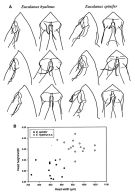 issued from : E. Goetze & J. Bradford-Grieve in Progress in Oceanography, 2005, 65. [Fig.7, p.68]. Species differences in the shape of the anterior portion of the female head in E. hyalinus s.s. and E. spinifer A: head shape in lateral and ventral views of three individuals of each species. B: ratio of height/width versus width of the anterior part of the head in both species.
|
 issued from : J.M. Bradford-Grieve in The Marine Fauna of New Zealand: Pelagic Calanoid Copepoda. National Institute of Water and Atmospheric Research (NIWA). New Zealand Oceanographic Institute Memoir, 102, 1994. [p.79, Fig.42]. Female (from Fleminger, 1973, p.989, Fig.13 c): A, habitus (dorsal and lateral pattern of integumental organs (black point = sites occuring at 100% frequency, o = 80-99% frequency, x = 10-79% frequency, triangle are sites which are also visible in lateral view but which are assigned to dorsal sets); Female (from South-west Pacific): B, habitus (dorsal); C, urosome (lateral left side); D, idem (dorsal); E, Md (mandibular palp). Male (from South -west Pacific): F, forehead; (dorsal); G, urosome (dorsal); H, P5 (lateral view); I, P5 (posterior view).
|
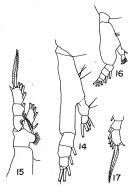 issued from : T. Park in Antarct. Res. Ser. Washington, 1968, 66 (3). [p.535, Pl.3, Figs.14-17]. As Eucalanus elongatus (from tropical Central North Pacific). Female: 14, Md (mandibular palp); 15, P1. Male: 16, Md (mandibular palp); 17, exopod of P1. Nota: These specimens are identical with hyalinus and are mainly characterized by the pointed postero-lateral corners of the metasome. The mandible palp has 3 short setae on the proximal part of the basis and 4 long setae plus 1 short seta on the 2nd endopodal segment. The 3rd exopodal segment of P1 has 1 external spine.
|
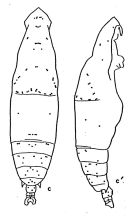 issued from : A. Fleminger in Fishery Bull. natn. Ocean. Atmos. Adm., 1973, 71 (4). [p.989, Fig.13]. Female: c, habitus (dorsal), c', idem (lateral right side). Nota:
Dorsal and lateral pattern of integumental organs (black point = sites occuring at 100% frequency, o = 80-99% frequency, x = 10-79% frequency, triangle are sites which are also visible in lateral view but which are assigned to dorsal sets);
|
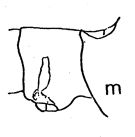 issued from : A. Fleminger in Fishery Bull. natn. Ocean. Atmos. Adm., 1973, 71 (4). [p.968, Fig.1, m (p.969). Female: m, genital segment (lateral right side).
|
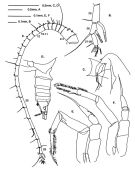 issued from : E. Goetze & J. Bradford-Grieve in Progress in Oceanography, 2005, 65. [p.80, Fig.13]. As Eucalanus hyalinus stricto sensu. Male (from 33°26'N, 117°54'W): A, left A1 (with ancestral segments 1, 2-4, 10-11, 12, 20, and 25 labeled); B, terminal part of left A1; C, forehead (lateral view); D, urosome (lateral, left side); E, P5 (anterior view); F, idem from another specimen (from 32°0.8'N, 119°14'W)
|
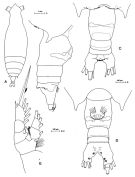 Issued from: M.G. Mazzocchi, G. Zagami, A. Ianora, L. Guglielmo & J. Hure in Atlas of Marine Zooplankton Straits of Magellan. Copepods. L. Guglielmo & A. Ianora (Eds.), 1995. [p.118, Fig.3.18.1]. As Eucalanus elongatus hyalinus. Female: A, habitus (dorsal); B, urosome (lateral right side); C, urosome (dorsal); D, urosome (ventral); E, P1. Nota: Last thoracic segment ornated with small spinules on dorsal posterior margin. urosome 4-segmented, anal somite and furca fused. Proportional lengths of urosomites and furca 48:15:9:28 = 100. left caudal ramus larger than right, left 2nd inner seta much stronger and longer than right. Anal somite with tufts of hairs and sparse spinules on ventral side and spinules along ridge of anal plate.
|
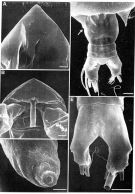 Issued from: M.G. Mazzocchi, G. Zagami, A. Ianora, L. Guglielmo & J. Hure in Atlas of Marine Zooplankton Straits of Magellan. Copepods. L. Guglielmo & A. Ianora (Eds.), 1995. [p.119, Fig.3.18.2]. As Eucalanus elongatus hyalinus. Female (SEM preparation): A, forehead (dorsal); B, idem (ventral, with elongated rostrum; C, urosome (dorsal); D, terminal points of last thoracic somite ending in conspicuous pores (arrow in C); E, asymmetrical caudal rami (ventral). Bars: A, B, C, E 0.100 mm; D 0.005 mm.
|
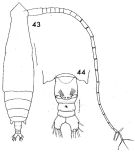 issued from : F.C. Ramirez in Contr. Inst. Biol. mar., Buenos Aires, 1969, 98. [p.46, Lam. VII, figs.43, 44]. As Eucalanus elongatus. Female (from off Mar del Plata): 43, habitus (dorsal); 44, urosome (dorsal). Scale bars in mm: 1 (43); 0.2 (44).
|
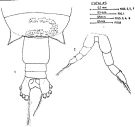 issued from : J. Corral Estrada in Tesis Doct., Univ. Madrid, A-129, Sec. Biologicas, 1970. [Lam.7, figs.1-2]. As Eucalanus elongatus. Female (from Canarias Is.): 1, posterior part cephalothorax and urosome. Male juvenil: 2, P5.
|
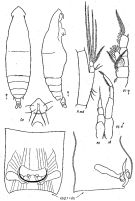 issued from : K.A. Brodsky, N.V. Vyshkvartzeva, M.S. Kos & E.L. Markhaseva in Opred Fauna SSSR, 1983, 135. [p.206, Fig.93]. Female & Male. Female, redrawn after Fleminger, 1973; Giesbrecht, 1892 (P.md: palp of Md; P1); Johnson, 1938. mMle: P5 after Gisebrecht, 1892; other figures from Pacific.
|
 Issued from : W. Giesbrecht in Systematik und Faunistik der Pelagischen Copepoden des Golfes von Neapel und der angrenzenden Meeres-Abschnitte. – Fauna Flora Golf. Neapel, 1892. Atlas von 54 Tafeln. [Taf.35, Fig.1]; As Eucalanus elongatus. With doubt. Female: 1, habitus (dorsal).
|
 Issued from : W. Giesbrecht in Systematik und Faunistik der Pelagischen Copepoden des Golfes von Neapel und der angrenzenden Meeres-Abschnitte. – Fauna Flora Golf. Neapel, 1892. Atlas von 54 Tafeln. [Taf.35, Fig.13, 23, 24]; As Eucalanus crassus. Female: 13, urosome (dorsal); 23, forehead (ventral); 24, idem (lateral).
|
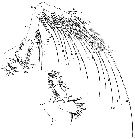 Issued from : W. Giesbrecht in Systematik und Faunistik der Pelagischen Copepoden des Golfes von Neapel und der angrenzenden Meeres-Abschnitte. – Fauna Flora Golf. Neapel, 1892. Atlas von 54 Tafeln. [Taf.11, Fig.2, 7]; As Eucalanus crassus. Female: 2, A2 (posterior); 7, Mx1 (osterior).
|
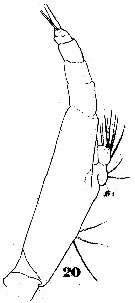 Issued from : W. Giesbrecht in Systematik und Faunistik der Pelagischen Copepoden des Golfes von Neapel und der angrenzenden Meeres-Abschnitte. – Fauna Flora Golf. Neapel, 1892. Atlas von 54 Tafeln. [Taf.11, Fig.20]; As Eucalanus crassus. Female: 20, Md (anterior).
|
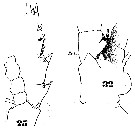 Issued from : W. Giesbrecht in Systematik und Faunistik der Pelagischen Copepoden des Golfes von Neapel und der angrenzenden Meeres-Abschnitte. – Fauna Flora Golf. Neapel, 1892. Atlas von 54 Tafeln. [Taf.11, Figs.25, 32]; As Eucalanus crassus. Female: 25, P2 (anterior); 32, basipod 2 of P1 (posterior)
|
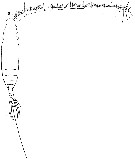 Issued from : W. Giesbrecht in Systematik und Faunistik der Pelagischen Copepoden des Golfes von Neapel und der angrenzenden Meeres-Abschnitte. – Fauna Flora Golf. Neapel, 1892. Atlas von 54 Tafeln. [Taf.35, Fig.2]; As Eucalanus crassus. Male: 2, habitus (dorsal).
|
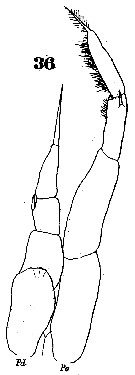 Issued from : W. Giesbrecht in Systematik und Faunistik der Pelagischen Copepoden des Golfes von Neapel und der angrenzenden Meeres-Abschnitte. – Fauna Flora Golf. Neapel, 1892. Atlas von 54 Tafeln. [Taf.11, Fig.36]; As Eucalanus crassus. Male: 36, P5 (posterior). Pd = right leg; Ps = left leg.
|
 issued from : M.W. Johnson, in Bull. Scripps Instn Oceanogr., 1938, tech. Ser., 4 (6). [p.166, Fig.3]. As Eucalanus elongatus hyalinus. With doubt Female (from California): 3, habitus (dorsal).
|
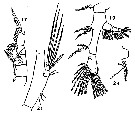 issued from : M.W. Johnson, in Bull. Scripps Instn Oceanogr., 1938, tech. Ser., 4 (6). [p.168, Figs.17, 19, 21, 24]. As Eucalanus elongatus hyalinus. With doubt. Female: 17, P1; 19, A2; 21, Md (mandibular palp); 24, posterior border of Mx2.
|
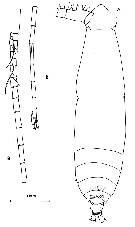 issued from : C. Razouls in Th. Doc. Etat Fac. Sc. Paris VI, 1972, Annexe. [Fig.24]. As Eucalanus elongatus. With doubt compared with E. spinifer. Female (from Banyuls, G. of Lion): A, habitus (dorsal); B-B', A1.
|
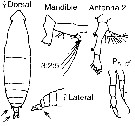 issued from : G. Harding in Key to the adullt pelagic calanoid copepods found over the continental shelf of the Canadian Atlantic coast. Bedford Inst. Oceanogr., Dartmouth, Nova Scotia, 2004. [p.40]. As Eucalanus elongatus. With doubt. Female & Male. Posterior border of metasome bluntly pointed in both sexes. Exopod of A2 scarcely reaching the middle of the 1st segment of endopod. Setae formula of Md 3: 2: 5. Urosome fmale 4-segmented.
|
 issued from : S.B. Schnack in Crustacean Issue, 1989, 6. [p.143, Fig.6, 6]. 6, As Eucalanus elongatus (from off NW Africa, upwelling region): Cutting edge of Md.
|
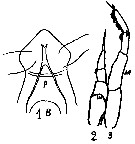 Issued from : M.C. Kos in Field guide for plankton. Zool Institute USSR Acad., Vol. I, 1972. As Eucalanus elongatus. After Brodsky, 1962 figs. 1, 2). Female: 1, forehead (ventral). p = rostrum. Male: 2, P5 (right and left legs)
| | | | | Ref. compl.: | | | Fleminger & Hulsemann, 1973 (p.343, carte); Carter, 1977 (1978) (p.35); Deevey & Brooks, 1977 (p.256, Table 2, Station "S"); Tremblay & Anderson, 1984 (p.5: Rem.); De Decker, 1984 (p.315, 347: carte); Cummings, 1984 (p.163, Table 2); Brenning, 1985 a (p.28, Table 2); Greze & al., 1985 (p.9); ? Madhupratap & Haridas, 1986 (p.105, tab.1); ? Chen Y.-Q., 1986 (p.205, Table 1: abundance %, Table 2: vertical distribution); Heinrich, 1990 (p.16); Flint & al., 1991 (p.199); Seguin & al., 1993 (p.26, Rem.); Voronina & Maslennikov, 1994 (p.632, fig.1); Paffenhöfer & al., 1996 (p.1699, motion behavior); Mauchline, 1998 (tab.15, 47, 56, 62); Gilabert & Moreno, 1998 (tab.1, 2); Suarez-Morales & Gasca, 1998 a (p.109); Dolganova & al., 1999 (p.13, tab.1); Lapernat, 2000 (tabl.3, 4); Pakhomov & al., 2000 (p.1663, Table 2, transect Cape Town-SANAE antarctic base): Razouls & al., 2000 (p.343, Appendix); Lapernat & Razouls, 2001 (tab.1); Escribano & Hidalgo, 2000 (p.283, tab.2); Hidalgo & Escribano, 2001 (p.159, tab.2); Rebstock, 2001 (tab.2); Mackas & Galbraith, 2002 a (p.423, Table 2); Rebstock, 2002 (p.71, Table 3, Fig.4, climatic variability); Paffenhöfer & Mazzocchi, 2003 (p.1150, fig.7); Hsiao & al., 2004 (p.325, tab.1); CPR, 2004 (p.53, fig.152); Shimode & al., 2005 (p.113 + poster); ? Lavaniegos & Jiménez-Pérez, 2006 (p.142, tab.2, 3, Rem); Mackas & al., 2006 (L22S07, Table 2); Hooff & Peterson, 2006 (p.2610); Khelifi-Touhami & al., 2007 (p.327, Table 1);McKinnon & al., 2008 (p.844: Tab.1); Neumann-Leitao & al., 2008 (p.799: Tab.II, fig.6); Muelbert & al., 2008 (p.1662, Table 1); C.-Y. Lee & al., 2009 (p.151, Tab.2); Galbraith, 2009 (pers. comm.); C.E. Morales & al., 2010 (p.158, Table 1); Schnack-Schiel & al., 2010 (p.2064, Table 2: E Atlantic subtropical/tropical); Hidalgo & al., 2010 (p.2089, Table 2); Fazeli & al., 2010 (p.153, Table 1, as halinus); Goetze & Ohman, 2010 (p.2110, Table 1, biogeography); Nowaczyk & al., 2011 (p.2159, Table 2); Zizah & al., 2012 (p.79, Tableau I); Hidalgo & al., 2012 (p.134, Table 2); Takahashi M. & al., 2012 (p.393, Table 2, water type index); Teuber & al., 2013 (p.1, Table 1, abundance vs oxygen minimum zone); in CalCOFI regional list (MDO, Nov. 2013; M. Ohman, comm. pers.); Kobari & al., 2013 (p.78, Table 2); Bode M. & al., 2013 (p.1, respiration rate & ETS activity); Schukat & al., 2013 (p.1, Table 1, 2, fig.2, respiration, ingestion); Peijnenburg & Goetze, 2013 (p.2765, genetic data); Bonecker & a., 2014 (p.445, Table II: frequency, horizontal & vertical distributions); Bode & al., 2015 (p.268, Table 1, chemical components, trophic level, geographic zone); Escribano & al., 2016 (p.1, growth rate); Benedetti & al., 2016 (p.159, Table I, fig.1, functional characters); Benedetti & al., 2018 (p.1, Fig.2: ecological functional group); Belmonte, 2018 (p.273, Table I: Italian zones); Bode & al., 2018 (p.840, Table 1, fig.5, respiration & ingestion rates, depth); Bode & al., 2018 (p.66, fig.5, vertical distribution %, Rem). | | | | NZ: | 19 | | |
|
Carte de distribution de Eucalanus hyalinus par zones géographiques
|
| | | | | | | | | | | | | | | | | |  issued from : E. Goetze & J. Bradford-Grieve in Progress in Oceanography, 2005, 65. [Fig.12, p.77]. issued from : E. Goetze & J. Bradford-Grieve in Progress in Oceanography, 2005, 65. [Fig.12, p.77].
Geographic distributions of E. hyalinus s.s. and E. spinifer.
Solid black circles correspond to E. hyalinus s.s., open circles to E. spinifer, and grey circles to plankton tows in which the species co-occurred. Neotype specimens marked by + and x, respectively.
Original distribution of E. hyalinus largo sensu outlined, after Fleminger & Hulsemann (1973). |
 issued from : A.A. Shmeleva in Bull. Inst. Oceanogr., Monaco, 1965, 65 (n°1351). [Table 6: 4 ]. As Eucalanus elongatus (from South Adriatic). issued from : A.A. Shmeleva in Bull. Inst. Oceanogr., Monaco, 1965, 65 (n°1351). [Table 6: 4 ]. As Eucalanus elongatus (from South Adriatic).
Dimensions, volume and Weight wet. Means for 50-60 specimens. Volume and weight calculated by geometrical method. Assumed that the specific gravity of the Copepod body is equal to 1, then the volume will correspond to the weight. |
 Issued from : M. Bode, R. Koppelmann, L. Teuber, W. Hagen & H. Auel inGlobal Biogeochemical Cycles, 2018, 32. [p.844, Table 1). Issued from : M. Bode, R. Koppelmann, L. Teuber, W. Hagen & H. Auel inGlobal Biogeochemical Cycles, 2018, 32. [p.844, Table 1).
Cf. explanations of these measures in Calanoides natalis from the same authors. |
 Issued from : M. Bode, A. Schukat, W. Hagen & H. Auel in J. Exp. Mar. Biol. Ecol., 2013, 444. [p.3, Table 1]. Issued from : M. Bode, A. Schukat, W. Hagen & H. Auel in J. Exp. Mar. Biol. Ecol., 2013, 444. [p.3, Table 1].
Dry mass, individual respiration rate and ETS activity from the northern Benguela Current upwelling system along transects at 23°S and 26°40'S, off Walvisbay and Lüderitz (Namibia).
Relationship between individual ETS activities and individual respiration rates; mean ETS activities with standard deviations are plotted again mean respiration rates (Cf. in Calanoides natalis. The letters besides each point identifies the associated species in Table 1 (a, i) for this species) in the same authors.
Cf. Table 1: Dry mass, individual respiration rate and ETS activity. |
| | | | Loc: | | | (?) sub-Antarct. (SW Atlant., Indian, SW & SE Pacif.), Straits of Magellan (Pacific area), Uruguay (continental shelf), off Rio de Janeiro, South Africa (E & W), Namibia, Angola, Atlant. (tropical & temperate), off E Sao Tomé Is., off Lagos, Ivorian shelf, Caribbean Sea, ? Bahia de Mochima (Venezuela), Jamaica, G. of Mexico, off W Bermuda, Florida, Sargasso Sea, Station "S" (32°10'N, 64°30'W), ? off E Cape Cod, off E Tristan da Cunha, off Trinidade Is., off N St. Helena Is., ? G. of Guinea, Dakar, Cape Verde Is., off Mauritania-NW Cape Verde Is., Mauritania-Morocco, Canary Is., off Madeira, ? Azores (in Farran, 1929), off W Cape Finisterre, Bay of Biscay, ? SE off Nova Scotia , S Davis Strait, Kejser Franz Josph mouth (rare), S & W Iceland, ? Wyville Thomson Ridge ( Pipe & Coombs, 1980), Norwegian Sea, W Ireland, off SW Ireland, North Sea, Ibero-moroccan Bay, Medit. (Alboran Sea, El Kala shelf, Banyuls, Marseille, Ligurian Sea, Tyrrhenian Sea, Strait of Messina, Gulf of Taranto, NW Tunisia, G. of Gabes, off Malta, Adriatic Sea, Ionian Sea, Aegean Sea, Alexandria), ? [Natal, Gulf of Oman, S Indian, Agulhas Current, Australia (North West Cape), New Zealand, off Washington coast, Oregon (off Newport), California, W Baja California, Pacif. (SE tropical), China Seas (East China Sea, in W. Zhang & al., 2010), Taiwan (E, NW), Japan Sea, Kuroshio Current, Pacif. (central N) (in Davis, 1949, p.16), off NE Hawaii, Peru, N Chile, Chile (S, off Santiago, Concepcion), ? S Pacif. (NPFZ), ? NW Pacif. (Taiwan)] | | | | N: | 195 ? | | | | Lg.: | | | [(14) F: 6,2-5,5; M: 4,15-4,05; (22) F: 8,25-4,4; M: 4,8-3,9; (25) F: 6,3; (36) F: 7,35-6,9; (54) F: 5,72; M: 4,05; (72) F: 7-5,95; M: 4,6-4,7; (75) F: 4,57; M: 4,67; 3,7; (79) F: 7-5,95; M: 4,7-4,6; (180) F: 5,54; 4,8; M: 4,64; 4,25; ? (199) F: 7,2-5,28; M: 4,8-4,26; (207) F: 5,9-5,5; M: 4,15; (340) F: 6,4; [ ! (386) F: 1,02; 0,8]; (449) F: 8,25-5,6; M: 4,8-3,9; ? (432) F: 8-5; (866) F: 4,4-5,8; M: 3,2-5; (916) F: 6,17-7,5; M: 4,83; {F: 4,40-8,25; M: 3,20-5,00}]
(966) F: 6,17-7,50 (13 samples from S Pacific, N Pacific, Indian)); M: 4,83, 4,92; {F: 6,17-7,50; M: 4,83-4,92} | | | | Rem.: | Epipélagique - ? (1000-1500 m in Bode & al., 2018).
bathypélagique (off Malte).
Sampling depth (sub-Antarct.) : 100-2500 m.
Vervoort, 1946 (p.91, 92) et 1963 b (p.88, 89) discute la non validité de cette forme qui est considérée comme valable par Fleminger (1973), et Brodsky & al. (1983).
Voir remarques à Eucalanus elongatus et Références entre crochets.
Goetze & Bradford (2005, p.82) distinguent morphologiquement et génétiquement Eucalanus spinifer de Eucalanus hyalinus. Goetze (2003) considère cette espèce comme circum-global (tropicale-subtropicale). les localisations géographiques fournies par les auteurs sont douteuses.
Voir aussi les remarques en anglais | | | Dernière mise à jour : 28/10/2022 | |
|
|
 Toute utilisation de ce site pour une publication sera mentionnée avec la référence suivante : Toute utilisation de ce site pour une publication sera mentionnée avec la référence suivante :
Razouls C., Desreumaux N., Kouwenberg J. et de Bovée F., 2005-2025. - Biodiversité des Copépodes planctoniques marins (morphologie, répartition géographique et données biologiques). Sorbonne Université, CNRS. Disponible sur http://copepodes.obs-banyuls.fr [Accédé le 22 octobre 2025] © copyright 2005-2025 Sorbonne Université, CNRS
|
|
 |
 |





























